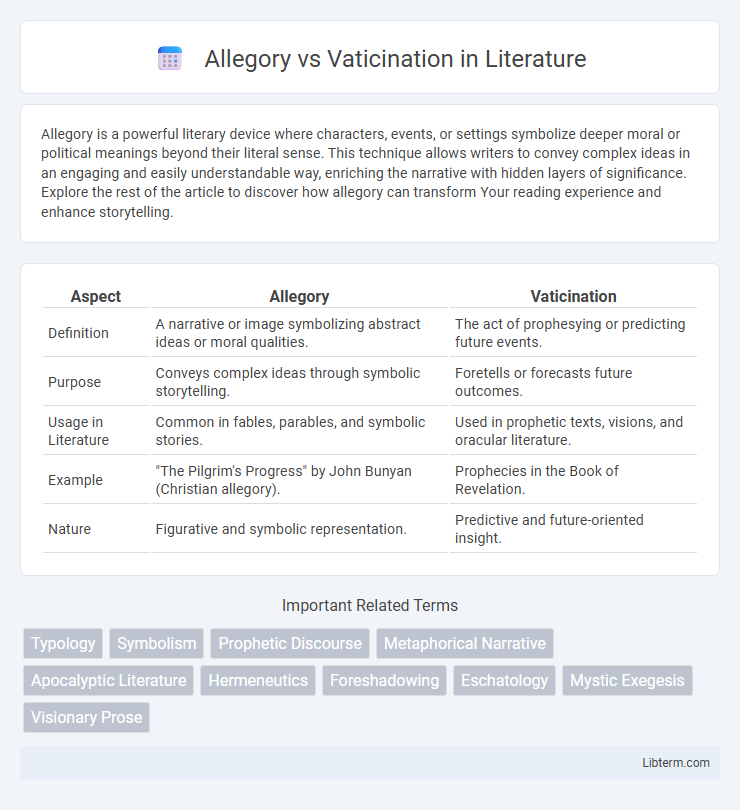Allegory is a powerful literary device where characters, events, or settings symbolize deeper moral or political meanings beyond their literal sense. This technique allows writers to convey complex ideas in an engaging and easily understandable way, enriching the narrative with hidden layers of significance. Explore the rest of the article to discover how allegory can transform Your reading experience and enhance storytelling.
Table of Comparison
| Aspect | Allegory | Vaticination |
|---|---|---|
| Definition | A narrative or image symbolizing abstract ideas or moral qualities. | The act of prophesying or predicting future events. |
| Purpose | Conveys complex ideas through symbolic storytelling. | Foretells or forecasts future outcomes. |
| Usage in Literature | Common in fables, parables, and symbolic stories. | Used in prophetic texts, visions, and oracular literature. |
| Example | "The Pilgrim's Progress" by John Bunyan (Christian allegory). | Prophecies in the Book of Revelation. |
| Nature | Figurative and symbolic representation. | Predictive and future-oriented insight. |
Introduction to Allegory and Vaticination
Allegory is a literary device that conveys complex ideas and moral lessons through symbolic figures and narratives, enabling deeper interpretation beyond the literal meaning. Vaticination refers to the act of prophesying or predicting future events, often rooted in spiritual or mystical insight. Understanding both concepts enhances comprehension of how literature and language explore abstract truths and foresight.
Defining Allegory: Symbolism in Narrative
Allegory employs symbolism in narrative to convey complex ideas and moral lessons through characters, events, and settings that represent broader concepts. This technique allows audiences to interpret layered meanings beyond the literal storyline, often reflecting cultural, political, or spiritual themes. Unlike vaticination, which involves prophetic prediction, allegory focuses on symbolic storytelling to communicate enduring truths.
Unpacking Vaticination: The Art of Prophecy
Vaticination, the art of prophecy, involves interpreting signs and symbols to predict future events with a deep connection to spiritual or divine insight. Unlike allegory, which uses symbolic storytelling to convey moral or philosophical truths, vaticination serves as a direct channel for foretelling destinies and revealing hidden knowledge. Mastery in vaticination relies on intuitive perception and often integrates ritualistic or cultural methods to enhance prophetic accuracy.
Historical Origins of Allegory
Allegory traces its historical origins to ancient civilizations, notably within Egyptian hieroglyphs and Greek philosophy, where symbolic storytelling conveyed moral, spiritual, or political lessons. Plato's use of allegory, seen in "The Allegory of the Cave," exemplifies early efforts to illustrate abstract philosophical ideas through narrative. This tradition evolved through medieval Christian theology, embedding allegory deeply in Western literary and artistic expressions.
Historical Roots of Vaticination
Vaticination, rooted in ancient civilizations such as Mesopotamia and Greece, often involved prophetic declarations believed to be divinely inspired, distinguishing it from allegory's symbolic storytelling. Historical records reveal that Vaticination was practiced by oracles and seers who interpreted omens and visions to predict future events. This practice emphasized direct communication of foresight, contrasting with allegory's metaphorical and illustrative approach in literature and art.
Key Differences Between Allegory and Vaticination
Allegory is a literary device where characters, events, or settings symbolically represent abstract ideas or moral qualities, often used to convey deeper meanings through narrative. Vaticination, or prophecy, involves foretelling future events or revealing hidden knowledge through inspired or supernatural insight. The key difference lies in allegory's focus on symbolic storytelling for interpretation, whereas vaticination centers on predictive or visionary revelation.
Allegory in Literature and Art
Allegory in literature and art serves as a powerful narrative technique where characters, events, or settings symbolically represent deeper moral, spiritual, or political meanings, offering layers of interpretation beyond the surface story. Renowned works like Dante's "Divine Comedy" and George Orwell's "Animal Farm" utilize allegory to critique societal issues and human nature through extended metaphors. This method enhances thematic complexity and invites readers or viewers to engage in critical reflection by decoding symbolic elements embedded in the creative work.
Vaticination in Religious and Cultural Texts
Vaticination in religious and cultural texts often manifests as prophetic revelations or divine foresight, providing believers with insights into future events or spiritual truths. This form of prediction shapes moral frameworks and guides communal decisions, reinforcing the authority of sacred scriptures. Unlike allegory, which conveys abstract ideas through symbolic storytelling, vaticination directly expresses anticipated outcomes believed to be divinely inspired.
Modern Interpretations: Allegory vs Vaticination
Modern interpretations distinguish allegory as a literary device that conveys complex ideas through symbolic narratives, enabling multiple layers of meaning and cultural analysis. Vaticination is primarily viewed as the act of prophecy or foretelling future events, often linked to intuition or divination rather than symbolic representation. Contemporary scholars emphasize allegory's role in critical theory and hermeneutics, whereas vaticination is studied within the contexts of mysticism and predictive discourse.
Choosing the Right Device: Allegory or Vaticination?
Choosing between allegory and vaticination depends on the intended narrative impact and audience engagement; allegory uses symbolic storytelling to convey complex themes subtly, ideal for exploring moral or philosophical concepts. Vaticination delivers direct prophetic insights or predictions, suitable for works aiming to foretell future events or provide authoritative warnings. Evaluating the desired clarity, depth, and tone helps determine whether the nuanced symbolism of allegory or the explicit foresight of vaticination better serves the communicative purpose.
Allegory Infographic

 libterm.com
libterm.com